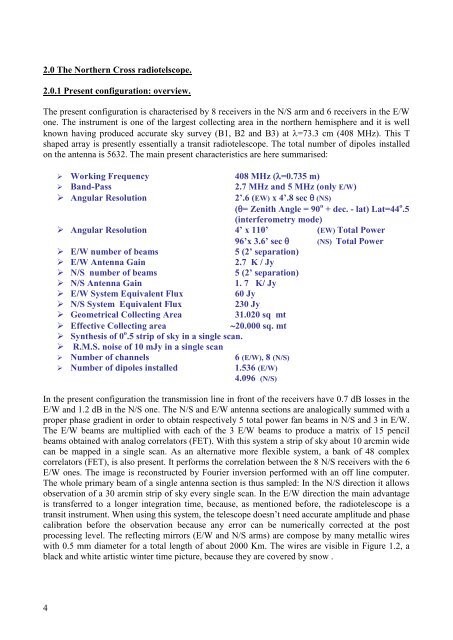The Medicina IRA-SKA Engineering Group
The Medicina IRA-SKA Engineering Group
The Medicina IRA-SKA Engineering Group
Create successful ePaper yourself
Turn your PDF publications into a flip-book with our unique Google optimized e-Paper software.
2.0 <strong>The</strong> Northern Cross radiotelscope.<br />
2.0.1 Present configuration: overview.<br />
<strong>The</strong> present configuration is characterised by 8 receivers in the N/S arm and 6 receivers in the E/W<br />
one. <strong>The</strong> instrument is one of the largest collecting area in the northern hemisphere and it is well<br />
known having produced accurate sky survey (B1, B2 and B3) at =73.3 cm (408 MHz). This T<br />
shaped array is presently essentially a transit radiotelescope. <strong>The</strong> total number of dipoles installed<br />
on the antenna is 5632. <strong>The</strong> main present characteristics are here summarised:<br />
‣ Working Frequency 408 MHz (=0.735 m)<br />
‣ Band-Pass<br />
2.7 MHz and 5 MHz (only E/W)<br />
‣ Angular Resolution<br />
2’.6 (EW) x 4’.8 sec (NS)<br />
(= Zenith Angle = 90 o + dec. - lat) Lat=44 o .5<br />
(interferometry mode)<br />
‣ Angular Resolution 4’ x 110’ (EW) Total Power<br />
96’x 3.6’ sec (NS) Total Power<br />
‣ E/W number of beams<br />
5 (2’ separation)<br />
‣ E/W Antenna Gain<br />
2.7 K / Jy<br />
‣ N/S number of beams<br />
5 (2’ separation)<br />
‣ N/S Antenna Gain<br />
1. 7 K/ Jy<br />
‣ E/W System Equivalent Flux<br />
60 Jy<br />
‣ N/S System Equivalent Flux<br />
230 Jy<br />
‣ Geometrical Collecting Area<br />
31.020 sq mt<br />
‣ Effective Collecting area<br />
20.000 sq. mt<br />
‣ Synthesis of 0 o .5 strip of sky in a single scan.<br />
‣ R.M.S. noise of 10 mJy in a single scan<br />
‣ Number of channels<br />
6 (E/W), 8 (N/S)<br />
‣ Number of dipoles installed<br />
1.536 (E/W)<br />
4.096 (N/S)<br />
In the present configuration the transmission line in front of the receivers have 0.7 dB losses in the<br />
E/W and 1.2 dB in the N/S one. <strong>The</strong> N/S and E/W antenna sections are analogically summed with a<br />
proper phase gradient in order to obtain respectively 5 total power fan beams in N/S and 3 in E/W.<br />
<strong>The</strong> E/W beams are multiplied with each of the 3 E/W beams to produce a matrix of 15 pencil<br />
beams obtained with analog correlators (FET). With this system a strip of sky about 10 arcmin wide<br />
can be mapped in a single scan. As an alternative more flexible system, a bank of 48 complex<br />
correlators (FET), is also present. It performs the correlation between the 8 N/S receivers with the 6<br />
E/W ones. <strong>The</strong> image is reconstructed by Fourier inversion performed with an off line computer.<br />
<strong>The</strong> whole primary beam of a single antenna section is thus sampled: In the N/S direction it allows<br />
observation of a 30 arcmin strip of sky every single scan. In the E/W direction the main advantage<br />
is transferred to a longer integration time, because, as mentioned before, the radiotelescope is a<br />
transit instrument. When using this system, the telescope doesn’t need accurate amplitude and phase<br />
calibration before the observation because any error can be numerically corrected at the post<br />
processing level. <strong>The</strong> reflecting mirrors (E/W and N/S arms) are compose by many metallic wires<br />
with 0.5 mm diameter for a total length of about 2000 Km. <strong>The</strong> wires are visible in Figure 1.2, a<br />
black and white artistic winter time picture, because they are covered by snow .<br />
4
















